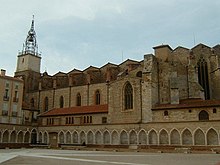Perpignan Cathedral
The Saint-Jean-Baptiste Cathedral ( German : Johannes-der-Täufer-Dom ) is a Roman Catholic church building in Perpignan, France, and the cathedral of the Perpignan-Elne diocese .
history
The church building was built in the 14th century in the Gothic style. Construction began in 1324. However, construction work stalled in the course of the 14th century and came to a standstill as a result of the waves of plague in Europe. Construction was not resumed until 1433 and was not completed until the beginning of the 16th century. The first mass was read in the church as early as 1453. It was consecrated on May 16, 1509. It was not until 1601 that the church was elevated to the status of a cathedral. In 1875 the cathedral was given by Pope Pius IX. additionally the title of a minor basilica .
The nave is 80 m long, 18 m wide and 22 m high. The vaults rest on the pillars of the side chapels.
Interior and equipment
The rich furnishings come from the centuries since construction began. The influences of the different stylistic epochs (Gothic, Renaissance, Baroque, Neo-Gothic) are very clear. The marble baptismal font from the 11th century is particularly noteworthy. Most of the windows date from the 19th century.
organ

The cathedral houses an organ , the origins of which are believed to be in the 15th century, and which has continued to grow over the centuries. The organ builder Aristide Cavaillé-Coll played a key role in today's instrument .
The first organ was probably built in the 15th century. The instrument had 21 stops on two manuals and a pedal . The date of construction and the builder are unknown. The imposing organ case, which is 19.75 m high and 8.8 m wide, has been preserved from this instrument.
Over the centuries the instrument has been changed, supplemented, rebuilt and the disposition expanded several times . In 1550 a Rückpositiv was added, which was removed by Cavaillé-Coll in the 19th century. In the years 1685–1688, the organ builder Jean de Joyeuse built a new organ; it had 28 registers on three manuals and a pedal. The instrument experienced a major turning point when it was reorganized by the organ builder Larroque in 1844 and expanded to 50 registers with three manuals and pedal. As early as 1854, Aristide Cavaillé-Coll was commissioned to build a new organ with 58 registers on four manuals and pedal, reusing 33 existing registers. The movement was set up in the original case, which faces the rear, i.e. H. to the wall of the nave was extended. The organ was inaugurated in 1857. In 1928–1930 the instrument was reorganized and expanded by 17 stops, and in 1991–1993 the organ builder Jean Renaud (Nantes) restored it to its 1857 condition. The organ today has 59 registers on four manuals and a pedal. The playing and stop actions are mechanical.
|
|
|
|
|
|||||||||||||||||||||||||||||||||||||||||||||||||||||||||||||||||||||||||||||||||||||||||||||||||||||||||||||||||||||||||||||||||||||||||||||||||||||||||||||||||||||||||||||||||||||||||||||||||||
The choir organ was built in 1879 by the organ builder Aristide Cavailéé-Coll. The instrument is hidden behind the main altar. It has 14 registers on two manuals, each of which is designed to be swellable. The pedal is attached, has no register of its own. The playing and stop actions are mechanical.
|
|
|
||||||||||||||||||||||||||||||||||||||||||||||||||||||||
- Coupling: II / I, I / P, II / P
Carillon
The cathedral has a carillon with 46 bells that was cast by Amédée Bollée in Le Mans in 1878 .
literature
Individual evidence
- ^ Basilique-Cathédrale Saint-Jean-Baptiste on gcatholic.org
- ↑ More information about the organ
- ↑ More information about the choir organ
- ↑ Chants des cloches, voix de la terre , Les Presses du Languedoc, pp. 241–246.
Web links
Coordinates: 42 ° 42 ′ 2 " N , 2 ° 53 ′ 49" E

















